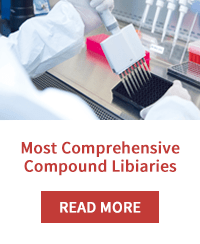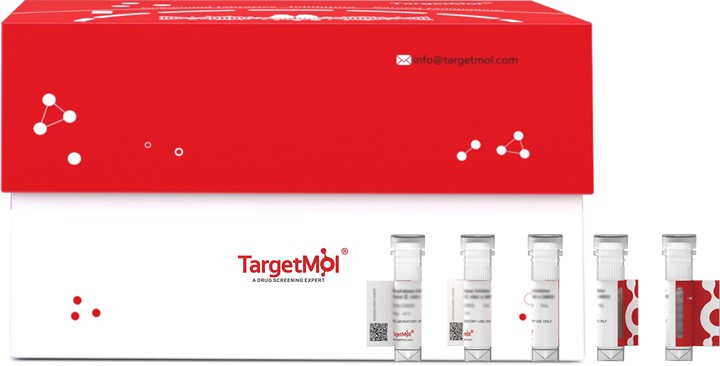

Azurocidin (AZU1), also known as heparin-binding protein (HBP) or cationic antimicrobial protein 37 (CAP37), is an azurophil granule antibiotic protein, with monocyte chemotactic and antibacterial activity. The Azurophil granules, specialized lysosomes of the neutrophil, contain at least 10 proteins implicated in the killing of microorganisms. Azurocidin is a member of the serine protease family that includes Cathepsin G, neutrophil elastase (NE), and proteinase 3 (PR3), however, Azurocidin is not a serine proteinase since the active site serine and histidine residues are replaced. Neutrophils arriving first at sites of inflammation release Azurocidin, which acts in a paracrine fashion on endothelial cells causing the development of intercellular gaps and allowing leukocyte extravasation. It thus be regarded as a reasonable therapeutic target for a variety of inflammatory disease conditions.

| Pack Size | Availability | Price/USD | Quantity |
|---|---|---|---|
| 100 μg | In stock | $ 386.00 | |
| 200 μg | 5 days | $ 660.00 | |
| 500 μg | 5 days | $ 1,340.00 |
| Biological Information | Testing in progress |
| Description | Azurocidin (AZU1), also known as heparin-binding protein (HBP) or cationic antimicrobial protein 37 (CAP37), is an azurophil granule antibiotic protein, with monocyte chemotactic and antibacterial activity. The Azurophil granules, specialized lysosomes of the neutrophil, contain at least 10 proteins implicated in the killing of microorganisms. Azurocidin is a member of the serine protease family that includes Cathepsin G, neutrophil elastase (NE), and proteinase 3 (PR3), however, Azurocidin is not a serine proteinase since the active site serine and histidine residues are replaced. Neutrophils arriving first at sites of inflammation release Azurocidin, which acts in a paracrine fashion on endothelial cells causing the development of intercellular gaps and allowing leukocyte extravasation. It thus be regarded as a reasonable therapeutic target for a variety of inflammatory disease conditions. |
| Species | Human |
| Expression System | HEK293 |
| Tag | His |
| Accession Number | P20160 |
| Synonyms | AZU, NAZC, azurocidin 1, hHBP, AZAMP, HUMAZUR, CAP37, HBP, AZU1 |
| Construction | A DNA sequence encoding the human AZU1 (NP_001691.1) (Met 1-Pro 250) with a C-terminal polyhistidine tag was expressed. |
| Protein Purity |
> 95 % as determined by SDS-PAGE
|
| Molecular Weight | Approxiamtely 25.6 kDa |
| Endotoxin | < 1.0 EU per μg of the protein as determined by the LAL method. |
| Formulation | Lyophilized from sterile PBS, pH 7.4. Please contact us for any concerns or special requirements. Normally 5 % - 8 % trehalose, mannitol and 0. 01% Tween 80 are added as protectants before lyophilization. Please refer to the specific buffer information in the hard copy of CoA. |
| Reconstitution | A hardcopy of datasheet with reconstitution instructions is sent along with the products. Please refer to it for detailed information. |
| Stability & Storage |
Samples are stable for up to twelve months from date of receipt at -20℃ to -80℃. Store it under sterile conditions at -20℃ to -80℃. It is recommended that the protein be aliquoted for optimal storage. Avoid repeated freeze-thaw cycles. |
| Shipping |
In general, recombinant proteins are provided as lyophilized powder which are shipped at ambient temperature.Bulk packages of recombinant proteins are provided as frozen liquid. They are shipped out with blue ice unless customers require otherwise. |
| Research Background | Azurocidin (AZU1), also known as heparin-binding protein (HBP) or cationic antimicrobial protein 37 (CAP37), is an azurophil granule antibiotic protein, with monocyte chemotactic and antibacterial activity. The Azurophil granules, specialized lysosomes of the neutrophil, contain at least 10 proteins implicated in the killing of microorganisms. Azurocidin is a member of the serine protease family that includes Cathepsin G, neutrophil elastase (NE), and proteinase 3 (PR3), however, Azurocidin is not a serine proteinase since the active site serine and histidine residues are replaced. Neutrophils arriving first at sites of inflammation release Azurocidin, which acts in a paracrine fashion on endothelial cells causing the development of intercellular gaps and allowing leukocyte extravasation. It thus be regarded as a reasonable therapeutic target for a variety of inflammatory disease conditions. |
bottom
Please read the User Guide of Recombinant Proteins for more specific information.
Azurocidin/CAP37 Protein, Human, Recombinant (His) AZU NAZC azurocidin 1 CAP 37 hHBP AZAMP HUMAZUR CAP-37 AZU 1 AZU-1 CAP37 HBP AZU1 recombinant recombinant-proteins proteins protein
